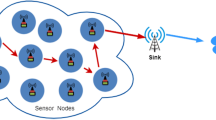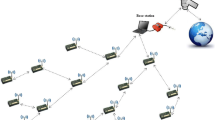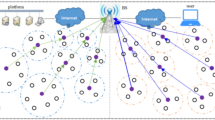Abstract
The significance of wireless sensor network (WSN) applications is to examine dangerous and remote fields that are not reachable or complex or expensive to reach human insights. This feature leads to self-managed networking that may face enormous confronts in energy consumption, fault tolerance and network lifetime based restraints owing certain non-renewable energy resources. From this research, an effectual managing strategy has been provided and methodology to tolerate faults in a network has been anticipated. To model these kinds of framework, fault recognition and revitalization approaches for handling diverse faulty levels have to be considered, i.e. communication and network nodes among them are used. The anticipated management strategy and protocol model may improve network-based fault tolerance ability in network nodes and corresponding transmission among them. As well as, network lifetime is increased for about five times higher than existing methods. Subsequently, it is validated that network fault tolerance proficiency is decreased with 2% and improved network lifetime with 10%. It improves data transmission and reduces energy consumption and increases network lifetime. Simulation is carried out in MATLAB 2018a environment. This model provides the finest results in terms of fault tolerance, network lifetime and energy consumption.














Similar content being viewed by others
References
Antoo A, Mohammed A (2014) EEM-LEACH: energy efficient multi-hop leach routing protocol for clustered WSNs. In: Proceedings of the International Conference on Control, Instrumentation, Communication and Computational Technologies (ICCICCT), Kanyakumari, India, 10–11 July 2014, pp 812–818
Ashraf D, Kanagachidambaresan GR, Maheswar R, Laktharia KI, Mahima V (2017) Buffer Capacity Based Node Life Time Estimation In Wireless Sensor Network. In: The Eighth IEEE International Conference on Computing, Communication And Networking Technologies (ICCCNT), IIT Delhi, 3rd–5th July, 2017
Bai X, Liu L, Cao M, Panneerselvam J, Sun Q, Wang H (2017) Collaborative actuation ofwireless sensor and actuator networks for the agriculture industry. IEEE Access 5:13286–13296
Charilas DE, Panagopoulos AD (2010) A survey on game theory applications in wireless networks. Comput Netw 54:3421–3430
Chen WB, Cui XL (2018) Hierarchical invulnerability topology construction method for IoT system. J Beijing Univ Posts Telecommun 41:1–5
Cheng L, Niu J, Luo C, Shu L, Kong L, Zhao Z, Gu Y (2018) Towards minimum-delay and energy-efficient flooding in low-duty-cycle wireless sensor networks. Comput Netw 134:66–77
Cheraghlou MN, Haghparast M (2014) A novel fault-tolerant leach clustering protocol for wireless sensor networks. J Circuits Syst Comp 23(3):1450041–1450047
Chhaya L, Sharma P, Bhagwatikar G, Kumar A (2017) Wireless sensor network based smart grid communications: cyber attacks, intrusion detection system and topology control. Electronics 6(1):1–5
El-Sherif M, Fahmy Y, Kamal H (2018) Lifetime maximization of disjoint wireless sensor networks using multi-objective genetic algorithm. IET Wirel Sens Syst 8(5):200–207
Hong Z, Pan X, Chen P, Su X, Wang N, Lu W (2018) A topology control with energy balance in underwater wireless sensor networks for IoT-based application. Sensors 18:2301–2306
Jayarajan P, Kanagachidambaresan GR, Sundararajan TVP, Sakthipandi K, Maheswar R, Karthikeyan A (2018a) An energy-aware buffer management (EABM) routing protocol for WSN. J Supercomput 6:1–13
Jayarajan P, Maheswar R, Kanagachidambaresan GR, Sivasankaran V, Balaji M, Das J (2018b) Performance evaluation of fault nodes using queue threshold based on N-policy priority queueing model. In: IEEE 9th International Conference on Computing, Communication and Networking Technologies (ICCCNT). pp 1–5
Jayarajan P, Maheswar R, Sivasankaran V, Vigneswaran D, Udaiyakumar R (2018c) Performance analysis of contention based priority queuing model using N-policy model for cluster based sensor networks. In: IEEE International Conference on Communication and Signal Processing (ICCSP), pp 0229–0233
Jayarajan P, Maheswar R, Kanagachidambaresan GR (2019) Modified energy minimization scheme using queue threshold based on priority queueing model. Clust Comput 22(5):12111–12118
Latiwesh A, Qiu D (2015) Energy efficient spectrum aware clustering for cognitive sensor networks: cogleach-c. In: Proceedings of the 10th International Conference on Communications and Networking, China (ChinaCom), Shanghai, China, 15–17 August 2015, pp 515–520
Leu JS, Chiang TH, Yu MC, Su KW (2015) Energy efficient clustering scheme for prolonging the lifetime of wireless sensor network with isolated nodes. IEEE Commun Lett 19(2):259–262
Liu K, Zhuang Y, Liang J, Ma J (2015) Spatiotemporal correlation based fault-tolerant event detection in wireless sensor networks. Int J Distrib Sens Netw 7:1–7
Liu XC, Wu ZF, Zhao KJ (2015) Algorithm for fault-tolerant topology control in heterogeneous and multi-hop wireless sensor networks. Syst Eng Electron 37:1902–1908
Liu J, Su S, Lu Y, Dong J (2018) Multiple layers uneven clustering algorithm based on residual energy for wireless sensor networks. J Eng 16:1555–1560
Mahdavi S, Shiri ME, Rahnamayan S (2015) Metaheuristics in largescaleglobal continues optimization: a survey. Inform Sci 295:407–428
Maheswar R, Jayaparvathy R (2010) Performance analysis using contention based queueing model for wireless sensor networks. In: The International Congress for global Science and Technology, pp 59–59
Maheswar R, Jayaparvathy R (2012) Performance analysis of fault tolerant node in wireless sensor network. In: International Conference on Advances in Communication, Network, and Computing. Springer, Berlin, Heidelberg, pp 121–126
Maheswar R, Maria AR, Sheriff N, Mahima V, Kanagachidambaresan GR, Lakshmi M (2019) Mobility Aware Next Hop Selection Algorithm (MANSA) for Wireless Body Sensor Network. In: IEEE 10th International Conference on Computing, Communication and Networking Technologies (ICCCNT), pp 1–5
Malathy S, Rastogi R, Maheswar R, Kanagachidambaresan GR, Sundararajan TVP, Vigneswaran D (2019) A novel energy-efficient framework (NEEF) for the wireless body sensor network. J Supercomput 1–16
Malathy S, Porkodi V, Sampathkumar A, NourHindia MHD, Dimyati K, Tilwari V, Qamar F, Amiri IS (2020) An optimal network coding based backpressure routing approach for massive IoT network. Wirel Netw 10(3):189–197
Mininno E, Cupertino F, Naso D (2008) Real-valued compact genetic algorithms for embedded microcontroller optimization. IEEE Trans Evol Comp 12(2):203–219
Mishra S, Jena L, Chakrabarty A, Choudhury J (2012) Fault tolerant multi cluster head data aggregation protocol in WSN (FMCDA). Int J Technol Explor Learn 1:32–36
Mitra S, Das A (2017) Distributed fault-tolerant architecture for the wireless sensor network’. Int J Comp Inform 41(1):4752–4758
Munir A, Antoon J, Gordon-Ross A (2015) Modeling and analysis of fault detection and fault tolerance in wireless sensor networks. ACM Trans Embed Comp Syst 14(1):1–43
Nageswari D, Maheswar R, Kanagachidambaresan GR (2019) Performance analysis of cluster based homogeneous sensor network using energy efficient N-policy (EENP) model. Clust Comput 22(5):12243–12250
Nigam GK, Dabas C (2018) ESO-LEACH: PSO based energy efficient clustering in LEACH. J King Saud Univ Comp Inform Sci. https://doi.org/10.1016/j.jksuci.2018.08.002
Osanaiye O, Alfa AS, Hancke GP (2018) A Statistical approach to detect jamming attacks in wireless sensor networks. Sensors 18:1685–1691
Sampathkumar A, Vivekanandan P (2019) Gene selection using PLOA method in microarray data for cancer classification. J Med Imaging Health Inform 9(6):1294–1300
Sampathkumar A, Mulerikkal J, Sivaram M (2020) Glowworm swarm optimization for effectual load balancing and routing strategies in wireless sensor networks. Wirel Netw. https://doi.org/10.1007/s11276-020-02336-w
Sampathkumar A, Murugan S, Rastogi R, Mishra MK, Malathy S, Manikandan R (2020) Energy Efficient ACPI and JEHDO Mechanism for IoT Device Energy Management in Healthcare. In: Kanagachidambaresan G, Maheswar R, Manikandan V, Ramakrishnan K (eds) Internet of Things in Smart Technologies for Sustainable Urban Development. EAI/Springer Innovations in Communication and Computing. Springer, Cham
Sengupta S, Chatterjee M, Kwiat K (2010) A game theoretic framework for power control in wireless sensor networks. IEEE Trans Comp 59:231–242
Sundararajan TVP, Ramesh SM, Maheswar R, Deepak KR (2014a) Biologically inspired artificial intrusion detection system for detecting wormhole attack in MANET. Wirel Netw 20(4):563–578
Sundararajan TVP, Sumithra MG, Maheswar R (2014b) A novel smart routing protocol for remote health monitoring in medical wireless networks. J Healthc Eng 5(1):95–122
Swain RR, Khilar PM, Bhoi SK (2018) Heterogeneous fault diagnosis for wireless sensor networks. Ad Hoc Netw 69:15–37
Thirumoorthy P, Kalyanasundaram P, Maheswar R, Jayarajan P, Kanagachidambaresan GR, Amiri IS (2019) Time-critical energy minimization protocol using PQM (TCEM-PQM) for wireless body sensor network. J Supercomput 1–11
Venkatesh S (2013) An efficient fault tolerant system using improved clustering in wireless sensor
Xu M, Yang Q, Kwak KS (2016) Distributed topology control with lifetime extension based on non-cooperativegame for wireless sensor networks. IEEE Sens J 16:3332–3342
Yang XS (2013) Flower pollination algorithm for global optimization. Unconventional computation and natural computation. Springer, Berlin, pp 240–249
Yetgin H, Cheung KTK, El-Hajjar M, Hanzo LH (2017) A survey of network lifetime maximization techniques in wireless sensor networks. IEEE Commun Surv Tutor 19(2):828–854
Younis M, Senturk IF, Akkaya K, Lee S, Senel F (2014) Topology management techniques for tolerating node failures in wireless sensor networks: a survey. Comput Netw 58:254–283
Zarifzadeh S, Yazdani N, Nayyeri A (2012) Energy-efficient topology control in wireless ad hoc networks with selfish nodes. Comput Netw 56:902–914
Zhang H, Zhang S, Bu W (2014) A clustering routing protocol for the energy balance of wireless sensor network based on simulated annealing and genetic algorithm. Int J Hybrid Inform Technol 7:71–82
Acknowledgements
This research was funded by the Deanship of Scientific Research at Princess Nourah Bint Abdulrahman University, Riyadh, Kingdom of Saudi Arabia through the Fast-track Research Funding Program.
Author information
Authors and Affiliations
Corresponding author
Additional information
Publisher's Note
Springer Nature remains neutral with regard to jurisdictional claims in published maps and institutional affiliations.
Rights and permissions
About this article
Cite this article
Shankar, A., Sivakumar, N.R., Sivaram, M. et al. Increasing fault tolerance ability and network lifetime with clustered pollination in wireless sensor networks. J Ambient Intell Human Comput 12, 2285–2298 (2021). https://doi.org/10.1007/s12652-020-02325-z
Received:
Accepted:
Published:
Issue Date:
DOI: https://doi.org/10.1007/s12652-020-02325-z




